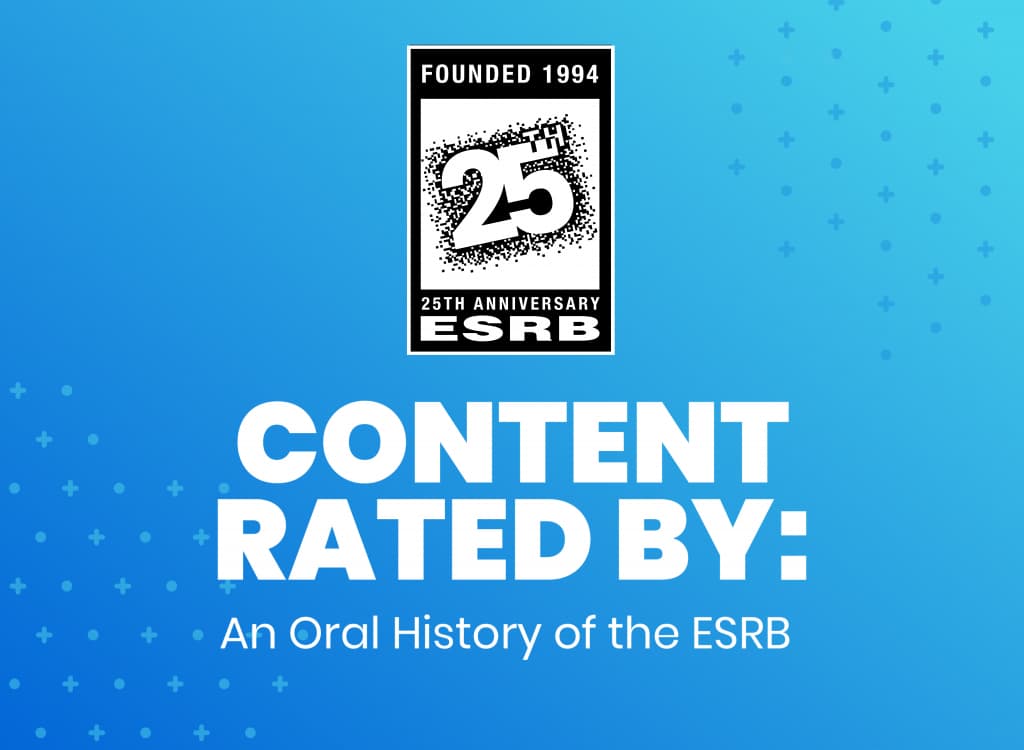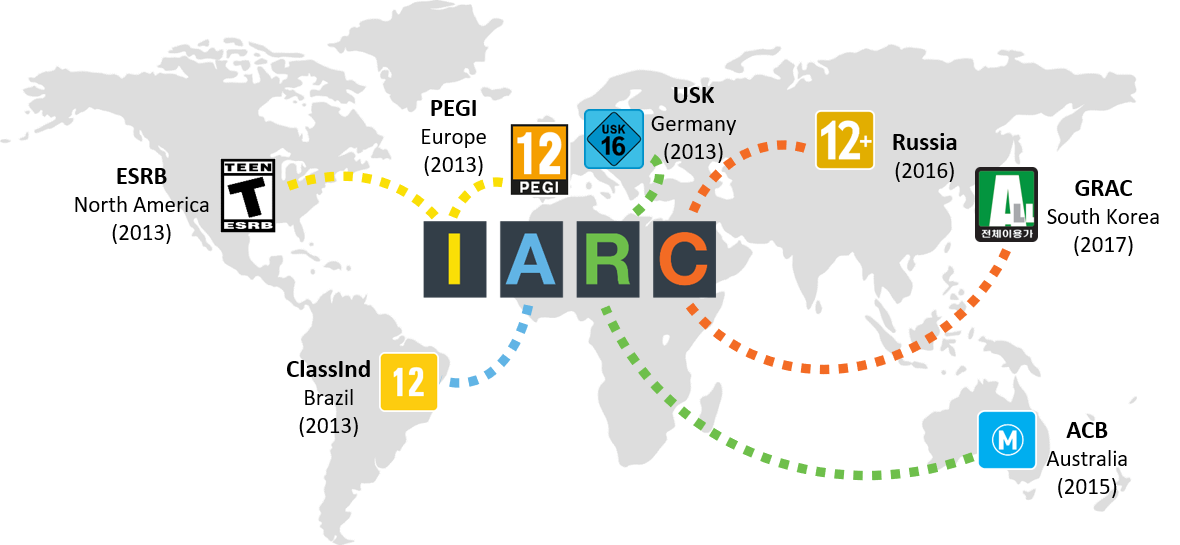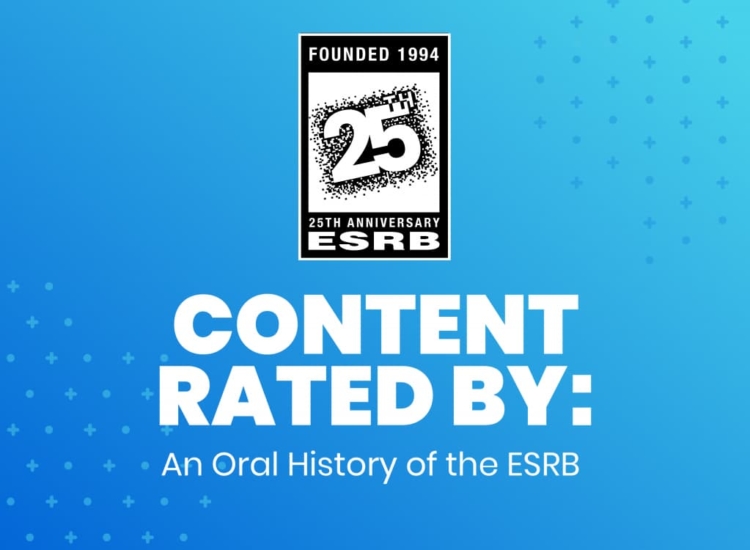Part 7: Think Globally, Act Digitally

To help commemorate its 25th anniversary, the Entertainment Software Rating Board (ESRB) reached out to Blake J. Harris, the best-selling author of Console Wars: Sega, Nintendo, and the Battle That Defined a Generation and The History of the Future: Oculus, Facebook and the Revolution That Swept Virtual Reality to document the behind-the-scenes origins of the rating system for video games and how it has evolved over the past quarter century. Content Rated By: An Oral History of the ESRB provides eyewitness accounts from the key people involved in the ESRB’s creation and its development into one of the country’s finest examples of industry self-regulation.
PART 7: Think Globally, Act Digitally
PAT VANCE (ESRB): In business, not everything you do is gonna be a homerun. But I think the most important thing is to always be looking around corners. Making sure that you can quickly adapt wherever the new technology or market is heading…
LISA SCHNAPP (ESRB): Whereas Arthur was an educator—a very smart one, by the way—Pat is first and foremost a businesswoman. She’s an amazing strategic thinker with great instincts.
PAT VANCE (ESRB): About ten-plus years ago, it became clear to me that we needed to prepare for the onslaught of digital and mobile games in terms of having a scalable solution. The current [Long Form] process we use for rating physical games is simply not capable of handling the volume of product we were seeing coming into the digital market, especially mobile.
BILL GARRITY (ESRB): So Pat had this idea that we could create a new algorithm-based rating system at a time when no one else on this Earth thought it was possible.
ROCCO BUFFALINO (ESRB): Including us.
BILL GARRITY (ESRB): Including us!
PAT VANCE (ESRB): The idea was to find a solution that not only was scalable, but a solution that was more friction-free for developers as well as storefronts. We needed some sort of automated solution that could handle the volume, yet still preserve the system’s integrity.
BILL GARRITY (ESRB): Like Rocco said: we were not really believers at the beginning.
ROCCO BUFFALINO (ESRB): We were straight-up haters. We were convinced it was never gonna work.
BILL GARRITY (ESRB): We just couldn’t understand: why was she so fixated on this?
PAT VANCE (ESRB): Because, in my view, if we didn’t create a digitally-oriented system like that, we’d be marginalized to extinction [reflective]. Our goal here is to make sure that ESRB ratings are accessible wherever games are played. I think that was the promise of the ESRB when it was established. Back then, we had a select number of console manufacturers and a select number of retailers to work with to make sure that these ratings were universally applied. But we were likely to see an explosion of both new devices and gatekeepers. So I wanted to make sure that we were ready.
In 2010, Vance began taking steps to make sure that would be the case.
PAT VANCE (ESRB): As Bill and Rocco probably told you, we have this extensive questionnaire that developers need to complete in order to get their physical games rated. I approached the ratings department and asked if there was a way that we can take the subjective process that happens in our brains when we look at content, and break that down into a series of multiple choice questions that developers can answer; and then have those answers fed into some sort of proprietary algorithm that would result in an accurate rating.
BILL GARRITY (ESRB): To Pat’s eternal credit, she didn’t just tell us we were wrong [to push back on her vision], she convinced us she was right. And not only did she convince us, but she got us excited about trying to build this thing—this program. We started by building something called the “Short Form” and the Short Form actually worked out a little bit okay…
PAT VANCE (ESRB): It took them many, many iterations. Not just of coming up with the right questions, but of creating a matrix of answers that would result in accurate ratings. To say the least, it was a real challenge. But eventually, we got to the point where we felt the output was pretty good. It wasn’t perfect, but it was pretty good. And we put this new system first to test with console downloadable games.
On April 18, 2011, the ESRB announced—via press release—a “new streamlined rating process for games that will only be sold and downloaded through console and handheld storefronts such as Microsoft Xbox LIVE Arcade, Nintendo Wii or DSi Shop and Sony PlayStation Store.” The announcement goes on to say that, “These games will receive the same recognizable ESRB ratings via a process whose efficiency and ease of use provides the scalability necessary to address the steady increase of games delivered digitally across an ever-expanding multitude of new devices and outlets.”
BILL GARRITY (ESRB): The human review process is really the apex of rating games. But… by having a scalable digital solution as the base of the pyramid, and quick triage ways to get up to the top in cases where you need to apply the more robust process—it worked pretty well and was more than a good start.
Meanwhile, as the ESRB’s focus on this new, hopefully-robust, hopefully-scalable ratings solution, something unrelated to the core business (though very related to the core mission) was taking place inside a courtroom in Washington, D.C.
The case in question—Brown v. Entertainment Merchants Association—was being argued in front of the Supreme Court, and however the case was decided would have First Amendment implications on the entirety of the video game industry.
The issue at hand stretched back to six years earlier—to a 2005 California bill (AB 1170), which opened with the following statement: “Exposing minors to depictions of violence in video games, including sexual and heinous violence, makes those minors more likely to experience feelings of aggression, to experience a reduction of activity in the frontal lobes of the brain, and to exhibit violent antisocial or aggressive behavior.” As a result of this premise, AB 1170 sought to prohibit the sale, or rental, of violent video games to minors (and, in doing so, granted the state the right to punish those who broke this law with a fine of up to $1,000 for each violation).

The Supreme Court Building
In a sense, this case stretched back much further than six years earlier—in effect, it went all the way back to 1993 when the game industry found itself on the brink of government regulation. To stave off that fate, the industry had been able to convince lawmakers to accept an alternate solution: self-regulation. Coming, of course, in the form of the ESRB.
So the question here, really, was whether or not that alternate solution had indeed proved suitable; as well as a broader question of whether or not video games were deserving of First Amendment protections akin to other popular forms of entertainment.
After listening to arguments, the U.S. Supreme Court decided on June 27, 2011, that like “books, plays, and movies” video games did indeed qualify for First Amendment protection. As part of the decision, Justice Scalia also explicitly noted “the video game industry has in place a voluntary rating system designed to inform consumers about the content of games”; a “system implemented by the Entertainment Software Rating Board (ESRB)”; and that this system already in place “does much to ensure that minors cannot purchase seriously violent games on their own, and that parents who care about the matter can readily evaluate the games their children bring home.”
For those working at the ESRB, the Supreme Court’s decision was incredibly affirming and, according to the ESA’s President and CEO at the time Mike Gallagher, essential.
MIKE GALLAGHER (ESA): The ESRB perhaps never stood taller than during the 2011 Supreme Court victory. The Supreme Court’s majority opinion lauded the strength of the ESRB system and its widespread use and acceptance as a critical component of cementing the First Amendment rights for the video game industry. Every game developer, publisher and gamer owes the ESRB a huge debt of gratitude.
And the timing of this couldn’t have been better, as Vance continued devoting more and more resources to the ESRB’s nascent, digital rating solution.
PAT VANCE (ESRB): While we were getting ready to launch the “Short Form” for downloadable console games, we were approached by CTIA [the trade association for companies in the wireless communications industry] to rate mobile games and apps. The CTIA had a number of member companies who were getting into the app store business—including Verizon, Microsoft and a number of the other carriers who were making noise about doing the same. So the CTIA came to us and said, “Can you create a system for us?” Working in coordination with the wireless industry, we expanded what we had created for the console downloadable market to be able to rate mobile apps, and not just games.
On November 29, 2011, the ESRB announced the “CTIA Mobile Application Rating System” which promised to provide consumers with “reliable information about age-appropriateness” for apps being distributed by six different mobile carriers (AT&T, Microsoft, Sprint, T-Mobile USA, U.S. Cellular, and Verizon Wireless).
PAT VANCE (ESRB): Once we’d launched the system with CTIA, we then began to approach the Apples and Googles of the world with our app ratings solution and asked them, “What do we need to do to make it viable for your storefronts?” One of the most important requirements for them was to make it into a global solution, not just a domestic one. I thought, ‘Well, as rating authorities, we’re all sort of dealing with very similar content regardless of the region; can’t we just take that same set of questions we developed and, since we don’t all weigh each criteria the same, program a different algorithm for the rating output in each region?’ For example: Europeans don’t care as much about sex and nudity; whereas we, as Americans, really do!
BILL GARRITY (ESRB): This meant that in addition to building out software capacity, we’d now also need buy-in from multiple different rating authorities around the world. That was obviously a tall order.
PAT VANCE (ESRB): So, off I went around the world, talking to a lot of different rating agencies—both self-regulatory agencies like us and a number of government rating agencies—none of whom had yet figured out how to adequately address the mobile market themselves. It was a tough sell—change or disruption can be a scary thing—but in the end we were able to convince more than a few key rating agencies to participate. My perspective was that if they didn’t get on board, we’d all be marginalized to death. Initially, our top target was PEGI [short for “Pan European Game Information,” the game rating system used by most countries in Europe]. Fortunately, PEGI agreed to work with us to come up with a common set of questions. We had to modify the questionnaire we had been using in the U.S. to address PEGI’s criteria and then help PEGI create its own algorithm that would result in appropriately assigned PEGI ratings. It was a lengthy process and they were skeptical at the beginning. But in the end, it worked well enough for them to agree to participate. Then USK [short for “Unterhaltungssoftware Selbstkontrolle,” the game ratings organization in Germany] came on board. So, we had Germany, Europe and ourselves. Brazil had a governmental rating agency that was trying to figure this all out too, and they wanted in.
On January 13, 2014, the participating rating authorities (ESRB, PEGI, USK and ClassInd) announced the creation of what they called the “International Age Rating Coalition” (IARC). And in 2014, Mozilla’s Firefox Marketplace became the first digital storefront to license IARC’s new global rating solution.
PAT VANCE (ESRB): Mozilla had an app storefront that was sort of below the radar. So for us, the fact that they were our first IARC storefront was ideal—almost like a beta test. After Mozilla, we worked really hard to get Google Play to adopt the system. Ultimately, we were successful and signed a license agreement with Google in December 2014—a huge step forward for IARC. But first we had to beef up our engineering resources to ensure that the system could handle the tsunami of Google Play apps that were about to come through it to be rated.
The system that the ESRB developed not only automated the assignment of ratings based on unique algorithms for each region, but it was designed as a SaaS solution [Software as a Service] that utilized web services to send ratings data back and forth between IARC and each storefront that licensed the system. It was essential that IARC controlled the rating that was displayed in the store. Every rating authority was responsible for monitoring the accuracy of the ratings that were being assigned and, when warranted, had to be able to correct the rating. This required a team of experienced engineers to develop, who could go toe-to-toe with the largest tech companies in the world.
DMITRI KALMAR (ESRB): We had 6 months to basically re-architect and rewrite the system in order to scale at the levels that a Google Play integration required. Luckily, most of the team we assembled at ESRB had previously worked together, so we knew each other well and our respective skillsets. It was bit of a mad dash, very intense, but very exciting.
And on an otherwise normal day in March 2015, Google Play turned on IARC’s global age-based rating system for all of the apps featured in its store in virtually every region in the world. At this point in time, Android—the mobile operating system on which Google Play lived—had over a billion users and the Google Play store which was featured on most Android devices had two million apps.
PAT VANCE (ESRB): That first day when Google started assigning IARC ratings…we rated more games that day than we had in the entire history of the ESRB. Probably in the first hour.
IARC continued to add numerous other storefronts in the following years, including Microsoft, Nintendo, Oculus, PlayStation and Origin. IARC was quickly becoming the new standard for rating digital games and mobile apps.
…
Read Part 8: Twenty-five Years Later… >>
The final part of Content Rated By: An Oral History of the ESRB fast-forwards 25 years to 2019 where the main players reflect on the creation and history of the ESRB. Part 8 will be published next week in the ESRB About section.
Blake J. Harris is the best-selling author of Console Wars: Sega, Nintendo and the Battle that Defined a Generation, which is currently being adapted for television by Legendary Entertainment.

